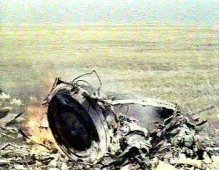Soyuz 1, manned by Vladimir Komarov, was launched into earth orbit by the Soviet Union on April 23, 1967. The next day, April 24, it began reentry. However, due to tangled shroud lines, its parachute failed to deploy fully, and the spacecraft slammed into the ground, killing Komarov.
According to Victor Yevsikov, a Soviet engineer who had worked on the Soyuz program, "Some launches were made almost exclusively for propaganda purposes. An example, timed to celebrate international solidarity, was the ill-fated flight of Vladimir Komarov in Soyuz 1. ... The management of the Design Bureau knew that the vehicle had not been completely debugged; more time was needed to make it operational. But the Communist Party ordered the launch despite the fact that four preliminary launches had revealed faults in the coordination, thermal control, and parachute systems. ... None of the tests were successful. During the first test flight the heat shield burned during descent. This was due to a defect in the stopper in the frontal shield, where the module had been mounted on the lathe for machining. The module was thoroughly damaged. The three other failures had different causes. Malfunctions in those test flights were due to a breakdown in the temperature control system, malfunctioning of the automatic controls of the attitude controljets, and burning of the parachute shroud lines."
Soyuz 1 needed more time to be developed, but in an attempt to push farther ahead in the race to the moon, the USSR launched Soyuz 1 too hastily, and as a result, Vladimir Komarov died tragically.
